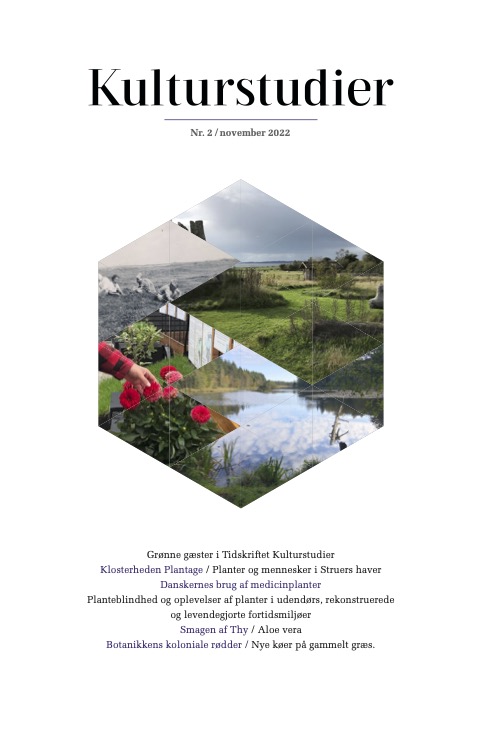Aloe Vera
En plantes rejse gennem natur- og kulturhistorien
DOI:
https://doi.org/10.7146/ks.v13i2.134664Nøgleord:
Aloe, Aloe Vera, Asphodelaceae, plantecellevægge, Polysakkarider, traditionel medicin, medicinske skrifterResumé
Aloe vera kendes af mange fra blomsterhandlerens potteplanter, apotekets håndkøbsprodukter eller supermarkedets sæbe- og cremesortiment. Planten er allestedsnærværende og kan beskrives som en nutidig kommerciel superstjerne. Aloe vera tilhører planteslægten Aloe, og er blot én ud af over 600 forskellige arter i denne slægt. Omkring 25% af aloerne har været brugt eller bruges i traditionel medicin i de områder, hvor de er naturligt forekommende. Slægten Aloe omtales i de tidligste medicinske skrifter, og aloerne er blevet brugt, delt, studeret og transporteret af både lægfolk og lærde folk igennem årtusinder. Det er tankevækkende, at én planteart er kommet til at dominere et kommercielt marked i en sådan grad, som Aloe vera gør i dag. De mange Aloe vera produkter på hylderne er dog et fint eksempel på et naturvidenskabeligt indhold pakket ind i en kulturhistorisk fortælling, der ligesom plantens egen historie repræsenterer en tæt sammenvævning af natur- og kulturhistorie.
Referencer
Ahl, L.I. (2019) Polysaccharide diversity across the genus Aloe. PhD dissertation. University of Copenhagen.
Ahl, L.I., Mravec, J., Jørgensen, B., Rudall, P., Rønsted, N., & Grace, O. M. (2019b) Dynamics of intracellular mannan and cell wall folding in the drought responses of succulent Aloe species. Plant Cell and Environment, 42, 2458-2471.
Ahl, L.I., Pedersen, H. L., Jørgensen, B., Willats, W. G. T., Grace, O. M., Barnes, C. J., Rønsted, N. (indsendt 2022) Exploring the composition of plant cell wall polysaccharides in succulent aloes.
Albersheim, P. (2011) Plant cell walls: from chemistry to biology. Garland Science.
Anderson 1977
Baldini, R. M., Cristofolini, G., Aedo, C. (2022) The extant herbaria from the Sixteenth Century: a synopsis. Journal of Plant Taxonomy and Geography. 77(1): 23-33.
Campbell Thompson (1949). A Dictionary of Assyrian Botany. The British Academy, London, England.
Clausen, M. H. & Madsen, R. (2003) Synthesis of Hexasaccharide Fragments of Pectin. Chem. Eur. J. 9: 3821-3832.
Das A., Haque SK. M., Ghosh B, Nandagopal K., Jha T. B. (2015). Morphological and Genetic Characterization of Micropropagated Field Grown Plants of Aloe vera L. Plant Tissue Cult. & Biotech. 25(2): 231-246.
De Toni, G.B. (1907) Sull’origine degli erbari. Atti Societač dei Naturalisti e Matematici di Modena, Ser. IV. 8: 18-22.
Fangel J., Pedersen, H. L., Vidal-Melgosa, S., Ahl, L. I., Salmean, A. A., Egelund, J., Rydahl, M. G., Clausen, M. H., Willats, W. G. T. (2012). Carbohydrate Microarrays in Plant Science. Methods in Molecular Biology. Vol. 918, kapitel 19, side 351-362
Fuchs, L. (1542) De Historia stirpium. Future Market Insights, (2016). Global demand for Aloe vera extracts to reach 60,720 tonnes in 2016; emergence of innovative, high-quality and cost- effective products ramping up adoption. Futur. Mark. Insights. Accessed March 2022. Available at: https://www.futuremarketinsights.com/reports/aloe-vera-extracts- market
Grace, O. M. (2011). Current perspectives on the economic botany of the genus Aloe L. (Xanthorrhoeaceae). South African Journal of Botany. 77, 980–987.
Grace, O.M. (2019). Succulent plant diversity as natural capital. Plants People Planet. 00, 1–10.
Grace, O.M., Klopper, R.R., Smith, G.F., Crouch, N.R., Figueiredo, E., Rønsted, N., van Wyk, A.E. (2013). A revised generic classification for Aloe (Xanthorrhoeaceae subfam. Asphodeloideae). Phytotaxa. 76, 7–14.
Grace, O. M., Buerki, S., Symonds, M. R. E., Forest, F., van Wyk, A. E., Smith, G. F., Klopper, R. R., Bjorå, C. S., Neale, S., Demissew, S., Simmonds, M. S. J. & Rønsted N. (2015). Evolutionary history and leaf succulence as explanations for medicinal use in aloes and the global popularity of Aloe vera. BMC Evolutionary Biology. 15, 29.
Haberlandt, G. (1914). Physiological plant anatomy (4th ed.) London: Macmilland and co.
Hodge, W. H. (1953) The drug aloes of commerce, with special reference to the Cape species. Economic Botany. 7: 99-129.
Linné, Carl von (1758) Systema Naturae.
Males, J. (2017) Secrets of succulence. Journal of Experimental Botany. 68, 2121-2134.
Newton, L. E. (1979) In defence of the name Aloe vera. Cat. Succ. J. (Gt. Brit.) 42: 3-4.
Newton, L. E. (2004) Aloes in habitat. In T. Reynolds (ed.), Aloes. The Genus Aloe: 3-14. CRC Pres, Boca Raton.
Personlig kommunikation med Lægemiddelstyrelsen, Regulatorisk og Klinisk Evaluering, angående status på Aloe vera som naturlægemiddel (juli 2022).
Pfitzer, E. (1877). Bemerkungen über die Wasseraufnahme abgeschnittener Pflanzenteile. Verhandlungen des Naturhistorisch Medizinschen Vereins zu Heidelberg, NF1, 503-508.
Reynolds, G. W. (1966) The Aloes of tropical Africa and Madagascar. Aloes Book Fund. Mbabane.
Reynolds, T. (ed.) (2004) Aloes. The Genus Aloe. (Medicinal and Aromatic Plants – Industrial Profiles. Vol. 38) CRC Pres, Boca Raton.
Reynolds, T. & Dweck, A. C. (1999). Aloe vera leaf gel: a review update. Journal of Ethnopharmacology. 68, 3–37.
Rowley, G. D. (1997) A history of Succulent Plants. Strawberry Press, Mill Valley, California.
Schaffrath, U. (1991). Läuse, Muscheln und Tabak – Das Herbar Ratzenberger. Philippia 15(3): 191-214.
Soelberg, J. (2022) søgt i database på www.alletiderslaegeplanter.dk (15/8-2022)
Downloads
Publiceret
Citation/Eksport
Nummer
Sektion
Licens
Tidsskriftet forbeholder sig ret til førsteudgivelsen, mens ophavsretten til artiklen tilfalder forfatteren.
Artikler udgivet af Kulturstudier licenseret under en Creative Commons Navngivelse-IkkeKommerciel-IngenBearbejdelse 4.0 International Licens





